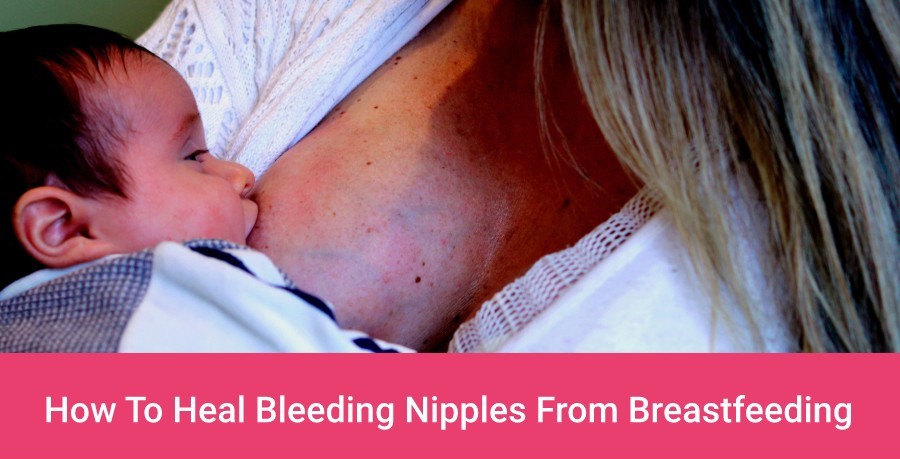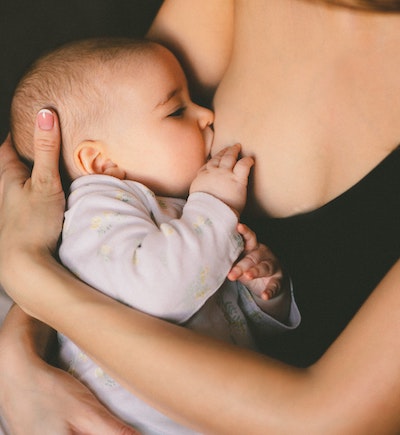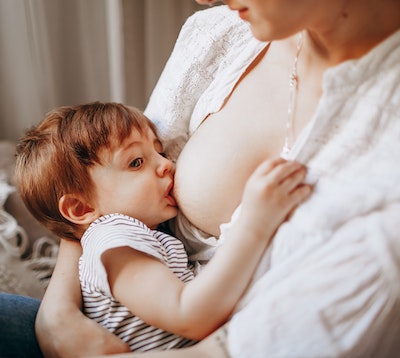
Article by Macy Tollefson – doula, breastfeeding specialist & prenatal yoga teacher
Many nursing moms experience cracked or bleeding nipples during the early days of breastfeeding. In fact, studies show that over 90% of breastfeeding mothers may suffer from painful and damaged nipples at some point!1
With that being said, just because it is common to experience nipple pain, does not mean you have to simply grin and bear it. Nipple problems are often an indicator that something is wrong, and it should be taken very seriously.
It is important to treat nipple damage, before it leads to more serious health issues that can affect you and your baby.
I know how challenging postpartum can be, and dealing with painful nipples only adds to the frustration – but don’t worry, I’m here to help!
Keep on reading to learn more about your damaged nipples, how to heal them, and when you should talk to a lactation consultant.
This article is not a substitute for medical advice.
What Causes Cracked Or Bleeding Nipples?
There are a number of reasons why you may be experiencing sore or cracked nipples. Here are some of the most common causes:
-
Shallow Latch
One of the most common causes of nipple pain is a result of your baby not being attached to your breast optimally. A “shallow” latch is one where the baby only has your nipple in their mouth, causing it to be crushed by their hard palate as they suck. Not only can this lead to nipple trauma, but it also causes a very ineffective milk transfer.
Remember: it’s called breast-feeding, not nipple-feeding.
If you think your baby is latching incorrectly, make sure to read my article about fixing shallow latch. It may be also a good idea to seek help from a certified breastfeeding consultant.
-
Breast Pump
A cracked nipple can also be caused from breast pumps that are too powerful or not used properly. The sensitive skin on your nipples can quickly be damaged by the suction of your breast pump.
-
Thrush
Thrush is a painful infection caused by an overgrowth of the candida fungus. If your baby has oral thrush, they can pass it on to you through breastfeeding, which will lead to very painful, red, cracked nipples.
-
Engorged Breasts
It’s common to experience engorged breasts when your milk comes in, but engorgement for prolonged periods can cause nipple soreness and a shallow latch.Leaking nipples from breasts that are too full can also cause nipple irritation, if your nursing pads are wet and rubbing on your skin. Bacteria can grow in this moisture, which could also lead to infection.
-
Tongue-Tie (Ankyloglossia)
A tongue-tie occurs when the tissue that attaches the tongue to the bottom of the mouth is too short, limiting the movement of the baby’s tongue2. This can cause a shallow, painful latch and ultimately cracked or bleeding nipples.
-
Breast Cancer
On very rare occasions, bloody discharge can be a sign of something more severe, such as cancer. If you are experiencing bleeding nipples or other concerning symptoms (such as breast lumps), seek professional medical advice.
It Is Normal To Have Bleeding Nipples While Breastfeeding?
Yes! One study found that 32% of nursing mothers experience cracked nipples (which often leads to bleeding) in the first 30 days of breastfeeding.3
While it is common for nursing moms to experience some nipple damage, it doesn’t mean that you need to live with the pain! Bleeding nipples ARE often a sign of a bigger problem and indicate that you need to make a change.

Symptoms Of Cracked Nipples
Sore, cracked nipples may look and feel different for everybody.
In some cases, you may see the broken skin right away. Other times, your nipples may look red or feel sore, before you notice any damaged skin.
If you notice a bleeding nipple, or even a pink or red tinge to your expressed milk, that is likely a sign that the skin has cracked as well.
Best Ways To Heal Cracked And Bleeding Nipples
The fastest and most effective way to heal cracked or bleeding nipples, is to get to the root cause. If you’re unsure of the source of the pain, reach out to a doctor or lactation consultant for help!
It’s important to treat cracked nipples quickly because it can lead to severe infections, such as mastitis, if left for too long.
A soothing, organic nipple cream is a great way to help heal sore or cracked nipples. A good balm or butter will create a moisturizing, healing barrier, and can be used before, during and after a feed.
Check out this article: Best Nipple Creams For Breastfeeding And Pumping Moms to see some of my favorite nipple butters!
Applying warm and cool compresses may also bring some relief. Cold compresses can help cool sore nipples and reduce swelling. Other mamas find a warm compress in comparison to be more soothing. Follow your intuition and see whether cool or warm compresses feels better for you.
If you don’t have access to a nipple butter, try rubbing your own breast milk onto your nipples and allow them to air dry.4 Breast milk contains natural skin softeners and antibodies that will fight infection and promote nipple healing.
| Note: This method should not be used if you have thrush. See below. |
Other good tips for healing cracked or bleeding nipples, is to do a saline rinse, try a nipple shield or breast shells, and breastfeed frequently.

What Products & Methods To Avoid
If the cause of your pain is thrush, avoid rubbing breast milk onto your nipples, as yeast grows quickly in human milk.5 It’s important to rinse your nipples off after feedings, if this is the case!
Avoid lanolin based creams, and opt for an organic nipple butter instead. See my article Nipple Butter Vs. Lanolin to learn which one is safest option for you and your little one.
Avoid nursing pads with plastic linings that restrict airflow and trap the moisture in. Always be sure to change nursing pads frequently to keep the area dry.
How To Prevent Bleeding And Cracked Nipples From Breastfeeding In The Future?
The number one way to prevent damaged nipples is achieving a deep, effective latch.
Try different nursing positions that allow your baby to attach to you breast correctly to optimize milk flow and keep the nipple from being continually damaged.
Use an organic nipple balm daily to keep the skin healthy, soothed and moisturized at all times, to prevent damage from occurring.
Can You Still Breastfeed If Your Nipples Are Bleeding?
As long as it is not too painful for you, yes – you can still breastfeed even if your nipples are bleeding.6
It may look alarming to see your breast milk turn red or pink from the blood, but it is completely safe for your baby to ingest. It really only takes a few drops of blood for the milk to turn red, so generally it is not as bad as it looks.
Until your nipples heal, you may see your baby spit up pink milk or pass dried blood in their poop. Again, this is normal, but if you are concerned, always reach out to your doctor for advice!

Should You Stop Breastfeeding Until Your Sore Nipples Heal?
In many cases, you don’t need to stop breastfeeding until you heal your sore nipples.
But everything depends on your nipples conditions! You will need to come up with a feeding plan for your unique situation.
Often times utilizing breastfeeding positions that help with latching properly is enough to reduce the pain of damaged nipples. When your baby’s latch is deep, it is the breast tissue that is being compressed, not the nipple.
With that being said, if you’re in pain from breastfeeding, it’s ok to take a break and pump instead!
Maybe one of your breasts is not as painful as the other – in that case, breastfeed on the one that is more comfortable, and pump the side that has more damage. You may need to switch to bottle feeding to supplement with your pumped milk.
It is important that you are continually expressing your milk while your nipples are healing, so you don’t diminish your supply or get mastitis.7
Your body creates milk on a supply and demand basis, meaning that the amount of milk you express, is the amount of milk it will continue to make. If you were to stop expressing milk for an extended period of time, your body will think that you no longer need it, and will ultimately stop your milk supply.
How Long Does It Take Bloody Nipples To Heal?
Usually it take a while to heal bloody nipples, but in general the sooner you intervene, the faster the healing process is going to be.
Everyone’s situation is unique, and healing time depends on a number of factors. A lactation consultant will be able to tell you what you can expect in your unique situation.
The bottom line? The sooner you intervene and begin the healing process, the faster you are likely to see positive results!
When Should You Visit A Doctor?
If you’re experiencing any pain AT ALL while breastfeeding or pumping, it’s best to reach out for professional support from a doctor or lactation consultant.
If your baby latches ineffectively, they will show you different feeding positions you can use to avoid breast pain or further damage.
If the source of your pain is from thrush, mastitis, or another infection, they will also work with you to find the best treatment plan, which may include a more intense intervention.
Seek professional support WHENEVER you are feeling concerned, but definitely if you are experiencing:
- Fever
- Chills
- A rash on the surrounding breast
- Nausea or vomiting
- Deep breast pain
- Hot, red skin on your breasts
You do not have to deal with this alone!
Medically Reviewed By Macy Tollefson
Macy Tollefson is a full spectrum doula, breastfeeding specialist and prenatal yoga teacher. She is passionate about guiding the modern mama on her journey through the beautiful (and wild) transformation of pregnancy, birth and postpartum. Macy envisions a world where every mother has access to the resources she needs, and follows her intuition to make the best decisions about what is right for her and her baby.
The purpose of this article is informative. It’s not a substitute for professional medical advice or medical care. Remember: safety first! Consult your doctor/pediatrician in case of any doubts. The author of this article does not accept any responsibility for any liability, loss or risk, personal or otherwise, incurred as a consequence, directly or indirectly, from any information or advice contained here.
Resources:
https://www.ncbi.nlm.nih.gov/
https://bmcpregnancychildbirth.biomedcentral.com/
https://www.mayoclinic.org/
https://momlovesbest.com/
https://www.healthline.com/
https://kellymom.com/
https://www.pampers.com/

